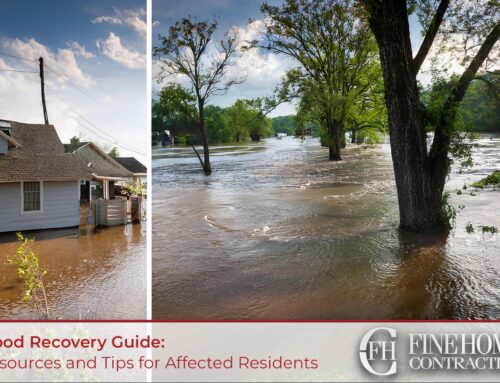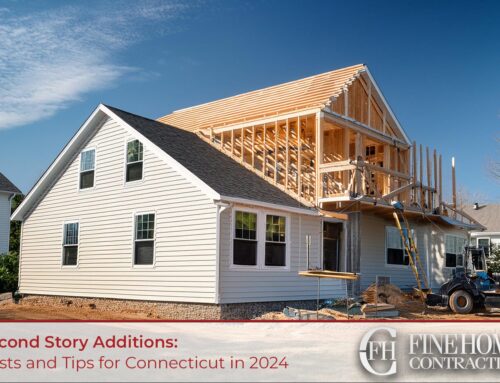Connecticut’s historic and high-end homes are architectural treasures, but their antique materials and craftsmanship also make them vulnerable to damage from storms, flooding, and other severe weather events. Homeowners considering major remodeling projects have an opportunity to incorporate upgrades that will protect their investment for generations to come. This guide provides tips on evaluating risks, working with specialized contractors, and proactively fortifying your home against wind, water, and other storm hazards.
Assess Your Home’s Vulnerabilities
The first step is having an assessment done by a qualified contractor familiar with historic homes. They can identify areas most prone to wind damage, flooding, leaks, and other issues specific to your property. Pay special attention to the roof’s structure and covering, windows, drainage, tree hazards, and the home’s foundation. Periodic assessments allow you to monitor any new problem areas and prioritize upgrades.
Roofing – Older homes often have roofing materials like slate, wood shakes, or tile that are more vulnerable to wind damage. Inspect your roof annually and repair any loose or missing shingles/tiles. Consider installing impact-resistant roofing before a storm hits.
Windows – Original windows in historic homes are often single-pane and loose fitting, making them prone to wind damage and leaks. Replace deteriorated putty sealing and glazing compound. Install storm windows or window film to reduce risk of breakage.
Landscaping – Overgrown trees and vegetation can cause damage if branches break off in high winds. Trim back trees and bushes near your home. Remove any dead or dying limbs that could fall and cause damage.
Prepare an Emergency Plan
Develop a storm preparedness plan so you know what to do in the event of a predicted severe storm or sudden emergency. Keep supplies like food, water, batteries, flashlights, and battery-powered radios. Secure important documents and valuables. Have a communication plan with family.
Prepare Your Home Before a Storm
Secure Loose Objects Outside – Bring patio furniture, potted plants, decorations and other loose items indoors where they won’t blow around in high winds and damage your home.
Trim Trees and Bushes – Remove dead or overhanging branches that could break off and cause damage. Hire an arborist if necessary for large limbs.
Clean Gutters and Downspouts – Make sure rain can flow freely and not back up. Clogged gutters can cause interior water damage.
Check Your Roof and Attic – Repair loose shingles/tiles, clear debris, and ensure proper attic ventilation to withstand high winds and rain.
Inspect Windows and Doors – Caulk and weatherstrip as needed to reduce air and water infiltration. Board up windows if necessary. Make sure doors have proper thresholds.
Prepare Appliances and Utilities – Turn off propane tanks, unplug electronics, and charge devices beforehand in case of power outage. Have a generator ready if possible.
Protect Yourself and Your Home During a Storm
While there are plenty of guides on storm safety out there, we thought it’d be worth mentioning some of the most important details to mind:
Stay Indoors – Evacuate if ordered. Otherwise stay inside away from windows and exterior doors during high winds and rain. Take shelter in an interior room on lower levels.
Monitor for Leaks and Damage – Keep an eye out for water intrusion, new cracks, or sounds indicating structural issues. Be ready to shut off utilities if compromised.
Avoid Using Appliances – Don’t operate electrical devices and appliances if flooding occurs, as they could get damaged or pose an electrocution risk.
Preventing Future Damage
While not every contingency can be planned for, especially when it comes to extreme weather, there are some steps that can be taken to make your home more storm-ready going forward. While these are larger, more involved projects, they also tend to add more safety and reliability to your home’s exterior and structure.
Consider Flood Insurance – Homeowner’s insurance policies generally don’t cover flood damage. Considering purchasing separate flood insurance if you are at risk of flooding during heavy storms or surges. Review policy terms closely to understand exactly what is covered.
Elevate HVAC Equipment – If you have ground-level outdoor HVAC systems, elevate them onto platforms above predicted flood levels. Many units can be elevated on brick or concrete piers. Enclose elevated equipment to prevent wind damage. Make sure units are properly anchored and secured.
Work With Contractors Specializing in Historic Homes – Look for contractors experienced in working with older, sensitive homes when planning renovations or upgrades. They will know the best ways to add storm protections without compromising the home’s historic character and structural integrity. Check references and qualifications closely.
Choose Impact-Resistant Building Materials – When it’s time to replace exterior elements like siding, look into impact-resistant, durable options that will hold up to storms. Materials like cement board and reinforced polymers won’t rot or mold. Consult local historical associations to find suitable materials that align with preservation codes.
Connecticut’s frequent storms and flooding events make proactive preparations a wise investment for protecting your historic home. Take time to assess vulnerabilities, work with knowledgeable specialists, and implement appropriate upgrades as part of your remodeling projects. Protecting your home today will preserve its unique architecture, craftsmanship, and your family’s enjoyment for generations to come.
FAQ
Should I replace my historic or antique roof after a storm?liam_c_wp2023-09-18T13:19:42+00:00Consult with roofing specialists experienced in historical restoration before replacing an antique roof. Often repairs, selective replacement of damaged areas, and added structural supports can preserve the roof’s integrity and historical design.,
How Do I Prepare my Pool for a Storm?liam_c_wp2023-09-18T13:18:52+00:00Prepare a pool for storms by lowering the water level, chemically treating the water, and shutting down electrical equipment. Install a pool cover tightly secured by water tubes or weights. Remove deck furniture and secure chemicals, pumps, and filters.,
How do I prepare my dock or boat for a storm?liam_c_wp2023-09-18T13:18:16+00:00 To prepare a dock for storms, secure all loose items and equipment, install extra dock lines and anchors, attach flotation devices, and ensure electrical lines and equipment are unplugged and protected from surges.
Should I cover stained glass windows during a storm?liam_c_wp2023-09-18T13:17:27+00:00Yes, protect stained glass windows during storms by covering them with plywood panels screwed into the window framing. Use closed cell foam weatherstripping to seal the edges before storm winds arise.,
How can I keep my basement dry during a hurricane?liam_c_wp2023-08-30T13:28:51+00:00Installing a sump pump, sealing the walls, adding flood vents, and installing a French drain system around your home will all help keep water out of your basement when heavy rains hit.
What are the best hurricane-resistant roof types?liam_c_wp2023-08-30T13:28:37+00:00Metal, clay tile, and impact-rated asphalt shingle roofs perform best in high winds. Lightweight metal allows wind to pass through, reducing uplift forces.
What are the most critical hurricane preparations for a home?liam_c_wp2023-08-30T13:28:06+00:00Reinforcing the roof, securing windows/doors, bracing the foundation, and controlling water flow are job one. Doing these things helps prevent total structural failure when a big storm hits.
How much does it cost to hurricane-proof an average home?liam_c_wp2023-08-30T13:27:22+00:00Total price varies a lot based on which upgrades you pick. But plan on at least $10K-$20K to tackle the essentials like roof bracing, storm windows, and waterproofing.







